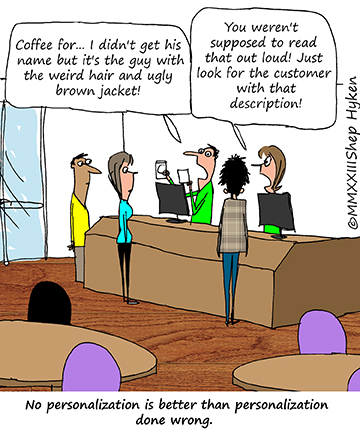
GUEST POST from Shep Hyken
One of the most powerful customer service and CX tactics is personalization. We interviewed more than 1,000 consumers for our CX research, and 71% said a personalized experience is important to them. When personalization is used correctly, customers feel as if you recognize them. Using their name, remembering their past purchases, their buying patterns and more can build confidence and trust.
While personalization is nice, it is not required, and if you decide to do it, there are some mistakes you must avoid. For example, if you’ve ever talked to a customer service agent who uses your name repeatedly to the point that it seems disingenuous, the effort to personalize fails. Another example came in the form of an email I recently received from a sales rep. It started out like this:
Dear <NOT PROVIDED>,
I hope this email finds you well. I wanted to discuss upgrading your current technology …
Obviously, my name is not “Not Provided.” I could tell the mail-merge field didn’t work. It took about two seconds for me to delete the email.
What made it worse was the next day, I received a phone call from the salesperson who sent the email. He didn’t ask for me by name. He asked for “the person in charge of technology.” So, this guy has my phone number and email address, but can’t get my name? His “personalization” strategy failed. As always, I’m polite to every salesperson who calls, but the conversation and relationship were over in less than a minute.

There are some pretty easy ways to create a personalized experience. Here are three of many to consider:
- Use the Customer’s Name – As already mentioned, be sure to use it correctly.
- Know the Customer’s Buying History – With the right software, you can track what the customer bought, how often and more.
- Make Appropriate Recommendations – Knowing your customer’s buying history can give you insights into up-sell and cross-sell opportunities. This isn’t a traditional sales pitch. It’s based on what you know about the customer. And if you know a customer can use something and don’t tell them about it, that is actually bad customer service.
While there are many more ideas, let’s wrap up with this. Personalization is about connecting with your customer. Be sure to do it right, whether it is as simple as using the customer’s name or as sophisticated as using data to understand your customer’s needs. No personalization is better than personalization done wrong.
Image Credits: Shep Hyken, Pexels
![]() Sign up here to join 17,000+ leaders getting Human-Centered Change & Innovation Weekly delivered to their inbox every week.
Sign up here to join 17,000+ leaders getting Human-Centered Change & Innovation Weekly delivered to their inbox every week.